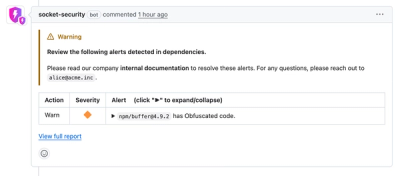
Security News
Crates.io Users Targeted by Phishing Emails
The Rust Security Response WG is warning of phishing emails from rustfoundation.dev targeting crates.io users.
Work in progress.
Enzyme-like testing utility built for the DOM and Web Components.
npm install bore --save-dev
Bore makes testing the DOM simpler in the same way Enzyme makes testing React simpler. It's built with Web Components in mind and follows similar conventions to Enzyme, but the APIs won't map 1:1.
/* @jsx h */
import { h, mount } from 'bore';
const wrapper = mount(<div><span /></div>);
console.log(wrapper.one('span').node.localName);
// "span"
Since web components are an extension of the HTML standard, Bore inherently works with it. However there are a few things that it does underneath the hood that should be noted.
flush() after mounting the nodes so things appear synchronous.attachShadow() method is overridden to always provide an open shadow root so that there is always a shadowRoot property and it can be queried against.Since Shadow DOM hides implementation details, it negates having to provide a way to do shallow rendering. Therefore, we only need to provide a simple way to wrap a component.
h(name, attrsOrProps, ...children)Bore ships with a simple JSX to DOM function that you can use as your JSX pragma, if that's your sort of thing.
/* @jsx h */
import { h } from 'bore';
console.log(<div />.localName);
// "div"
If you don't want to configure the pragma and you want to just leave it as React, you can do the following:
import { h } from 'bore';
const React = { createElement: h };
console.log(<div />.localName);
// "div"
This can probably be confusing to some, so this is only recommended as a last resort.
The h function sets always props. If you wanna set something as an attribute, such as aria- or data- or anything else h accepts special attrs prop.
For setting event handlers use events property.
As a best practice, your web component should be designed to prefer props and reflect to attributes only when it makes sense.
Example:
/* @jsx h */
import { h } from 'bore';
const dom = <my-skate
brand="zero" // this will always set to element property
attrs={{ // this will always set to element attributes
'arial-label':'skate',
mastery: 'half-pipe'
}}
events={{ // this will set event handlers on element
click: e => console.log('just regular click'),
kickflip: e => console.log('just did kickflip')
}}
></my-skate>
mount(htmlOrNode)The mount function takes a node, or a string - and converts it to a node - and returns a wrapper around it.
import { mount, h } from 'bore';
mount(<div><span /></div>);
A wrapper is returned when you call mount():
const wrapper = mount(<div><span /></div>);
The wrapper contains several methods and properties that you can use to test your DOM.
nodeReturns the node the wrapper is representing.
// div
mount(<div />).node.localName;
all(query)You can search using pretty much anything and it will return an array of wrapped nodes that matched the query.
You can use element constructors to search for nodes in a tree.
mount(<div><span /></div>).all(HTMLSpanElement);
Since custom elements are just extensions of HTML elements, you can do it in the same exact way:
class MyElement extends HTMLElement {};
customElements.define('my-element', MyElement);
mount(<div><my-element /></div>).all(MyElement);
Custom filtering functions are simply functions that take a single node argument.
mount(<div><span /></div>).all(node => node.localName === 'span');
You can mount a node and search using a different node instance as long as it looks the same.
mount(<div><span /></div>).all(<span />);
The node trees must match exactly, so this will not work.
mount(<div><span>test</span></div>).all(<span />);
You can pass an object and it will match the properties on the object to the properties on the element.
mount(<div><span id="test" /></div>).all({ id: 'test' });
The objects must completely match, so this will not work.
mount(<div><span id="test" /></div>).all({ id: 'test', somethingElse: true });
You can pass a string and it will try and use it as a selector.
mount(<div><span id="test" /></div>).all('#test');
one(query)Same as all(query) but only returns a single wrapped node.
mount(<div><span /></div>).one(<span />);
has(query)Same as all(query) but returns true or false if the query returned results.
mount(<div><span /></div>).has(<span />);
wait([then])The wait() function returns a promise that waits for a shadow root to be present. Even though Bore ensures the constructor and connectedCallback are called synchronously, your component may not have a shadow root right away, for example, if it were to have an async renderer that automatically creates a shadow root. An example of this is Skate's renderer.
mount(<MyComponent />).wait().then(doSomething);
A slightly more concise form of the same thing could look like:
mount(<MyComponent />).wait(doSomething);
waitFor(funcReturnBool[, options = { delay: 1 }])Similar to wait(), waitFor(callback) will return a Promise that polls the callback at the specified delay. When it returns truthy, the promise resolves with the wrapper as the value.
mount(<MyElement />).waitFor(wrapper => wrapper.has(<div />));
This is very usefull when coupled with a testing framework that supports promises, such as Mocha:
describe('my custom element', () => {
it('should have an empty div', () => {
return mount(<MyComponent />).waitFor(w => w.has(<div />));
});
});
FAQs
Enzyme-like testing for the DOM.
We found that bore demonstrated a not healthy version release cadence and project activity because the last version was released a year ago. It has 1 open source maintainer collaborating on the project.
Did you know?

Socket for GitHub automatically highlights issues in each pull request and monitors the health of all your open source dependencies. Discover the contents of your packages and block harmful activity before you install or update your dependencies.

Security News
The Rust Security Response WG is warning of phishing emails from rustfoundation.dev targeting crates.io users.

Product
Socket now lets you customize pull request alert headers, helping security teams share clear guidance right in PRs to speed reviews and reduce back-and-forth.

Product
Socket's Rust support is moving to Beta: all users can scan Cargo projects and generate SBOMs, including Cargo.toml-only crates, with Rust-aware supply chain checks.